|
Being held from 1929 to 1961
(with the exception of World War II years), the Thompson Trophy Race was one
of the longest running airplane speed events. The closed course was 10 miles long
and used 50-foot-high pylons. Through 1949 hen this article appeared in Air
Trails magazine, most events were held in Cleveland, Ohio. Museum photos of
many of the airplanes can be seen on
Wikipedia. Looking
through the list of winners' names, the most recognizable to most people is
Jimmy Doolittle,
famous for his air strike on the Japanese mainland using B-25 bombers launched from
the USS Hornet aircraft carrier. That was in 1942, but Doolittle won his Thompson
Trophy Race title in 1932, a full decade earlier. The
Reno Air Races began
in 1964 and is still held every year to this day, except for in 2020 when China's
Wuhan Virus (COVID-19) cause it to be cancelled - for no good reason as it turns
out.
Aerial Hot-Rods: History of the Thompson Trophy Race
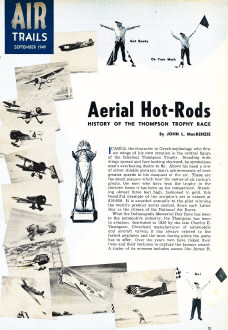 By John L. MacKenzie By John L. MacKenzie
Icarus, the character in Greek mythology who flew on wings of his own creation
is the central figure of the fabulous Thompson Trophy. Standing with wings spread
and face looking skyward, he symbolizes man's everlasting desire to fly. Above his
head a row of silver shields portrays man's achievements of ever greater speeds
in his conquest of the air. These are the small plaques which bear the names of
air racing's greats, the men who have . won the trophy in the thirteen times it
has been up for competition. Standing almost three feet high, fashioned in gold,
this beautiful example of the sculptor's art is valued at $10,000. It is awarded
annually to the pilot winning the world's premier aerial contest, flown each Labor
pay as the climax of the National Air Races.
What the Indianapolis Memorial Day Race has been to the automotive industry,
the Thompson has been to aviation. Instituted in 1930 by the late Charles E. Thompson,
Cleveland manufacturer of automobile and aircraft valves, it has always catered
to the fastest airplanes and the most daring pilots the game has to offer. Over
the years men have risked their lives and their fortunes to capture the famous award.
A roster of its winners includes names like James H. Doolittle and Roscoe C. Turner.
Also included are men who were wholly unknown before they captured the Trophy.
|
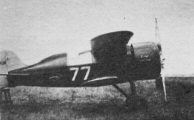
1930: Laird Solution, 201.91 mph.
|
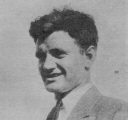
Charles W. "Speed" Holman, noted stunt and speed pilot, winner
of the 1930 Thompson Trophy Race.
|
|
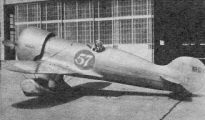
1931: Gee Bee, 236.24 mph
|

1931 winner was Lowell Boyles, who later met an untimely death
in a crash in his fast Gee Bee racer.
|
|

1932: Gee Bee, 252.69 mph.
|

"Jimmy" Doolittle, famed for his raid on Tokyo, won in 1932.
His speed was unsurpassed for three years.
|
|

1933: Weddell-Williams, 237.95 mph.
|
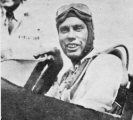
1933 winner was James R. Weddell. This flyer was better known
for the design of his racing planes.
|
|

1934: Weddell-Williams, 248.13 mph.
|
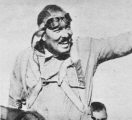
Most colorful pilot of the racing circuit was Colonel Roscoe
Turner, who took first place in the 1934 race.
|
|

1935: Howard, 220.19 mph.
|
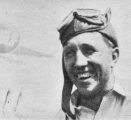
Harold Neumann won the race in 1935. He flew Benny Howard's fast,
white-and-gold Mister Mulligan.
|
|
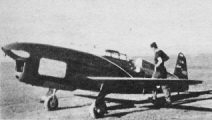
1936: Caudron, 264.26 mph.
|
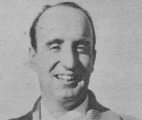
The only foreign pilot ever to fly in the Thompson Race was Michel
Detroyat, who won spectacularly in '36.
|
|
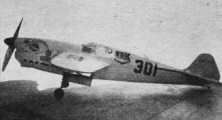
1937: Folkerts, 256.91 mph.
|

In his small Folkerts, Rudy Kling took first place in the '47
race. He was loter killed in this craft at Miami.
|
|

1938-39: Turner-Laird, 283.41 & 282.53 mph.
|

In 1938 and 1939 the Thompson Trophy was won by Roscoe Turner,
the only pilot to win it three times.
|
|
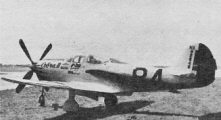
1946: Bell F-39Q Cobra II, 373.90 mph.
|
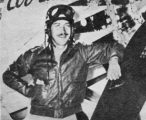
The first post-war winner was 1946's Alvin "Tex" Johnson. With
his victory was started the military plane era.
|
|
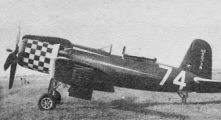
1947: Goodyear F2G-1, 396.13 mph.
|
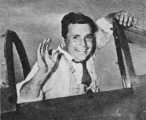
Fastest speed ever reached in a Thompson Race was by Cook Cleland
who won in '47 with his big Corsair.
|
|
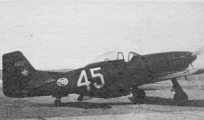
1948: North American F-51, 383.76 mph.
|
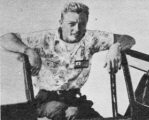
Trouble with Chuck Brown's Cobra II and Cleland's Corsair helped
Anson Johnson win Trophy in 1948.
|
There is no other race like the Thompson. It is the only closed circuit competition
in the world open to any type of propeller-driven airplane regardless of horsepower.
Consequently it is the fastest, most exciting race ever run before human eyes. Planes
of tremendous power, flying bunched together at tree top level, swinging around
pylon turns in perpendicular banks and. roaring down the straightaways at terrific
speed are characteristic of the Thompson. A dangerous game at best, it is one of
the most severe tests to which flying men and machines can be put.
When Mr. Thompson established this race, he stipulated the rules which have made
it a free-for-all event. It was definitely his aim to stimulate the development
of faster aircraft at a time when our nation was lagging behind European accomplishments
in that field. Contrasting the winning speed of 201.91 miles per hour registered
by Charles W. Holman in 1930 with Cook Cleland's present day record of 396.131 mph
gives a fair idea of just how much that goal has been realized.
Although the race has fulfilled its objective over the years as a proving ground
of the industry, it has gone even farther. It has made of air racing a spectacular
show which plays to the largest audiences ever assembled for one sport. Upwards
of a half million spectators will congregate at Cleveland this Labor Day, as they
have in previous years, to witness the big event. The very nature of the race makes
it impossible to confine it to the paying customers. Since it is flown around a
fifteen-mile rectangular course, only the start and finish line, the No.1 pylon
and the homestretch are in view of the Air Race grandstands. As the high-speed planes
roar around this circuit fifteen times they will be flying over the heads of countless
thousands in the surrounding countryside.
Each of the thirteen races that have been run to date constitutes a tale worth
telling. Together they add up to a dramatic history that reads like pages of fiction.
Take for instance the case of that first race. "Speed" Holman was a well known figure
in the air racing circles of that day. He also served as test pilot for the small
E. M. Laird Airplane Company in Chicago. Just one month before the race was scheduled
to be flown, his employer accepted a contract to build a racing plane for Lee Schoenhair
of the B. F. Goodrich Company. And it was just one hour before the race that the
ship was finished. In view of this shortness of time at the very last minute, test
pilot Holman flew the untried ship across town to the racing field, and replaced
Schoenhair in the starting lineup.
Captain Arthur H. Page of the U. S. Marine Corps was favored to win that day,
but Captain Page crashed to his death while leading the field in the seventeenth
lap. That tragedy left the Laird Solution at the head of the pack to finish what
was then a 100-mile race. So a substitute pilot in an untried airplane won the first
spot on the new Thompson Trophy.
The most spectacular happening in Thompson history must be accredited to Colonel
Roscoe C. Turner, dean of all racing pilots. It was back in 1935 that it occurred,
the year after Colonel Turner had won the trophy for the first time. Determined
to become the first man to repeat a victory; he had completely rebuilt his famous
Wedell Williams racing plane to make it superior to any in the field. And on the
qualities of his racer, to say nothing of his experience and personal ability in
the cockpit, Roscoe was rated the unquestioned favorite to win.
From the start of the race Turner had the lead to himself in the expected manner.
And he increased that lead until he had lapped everyone in the field. Then the unexpected
happened! Rounding the south pylon and approaching the airport at tree-top level,
his golden monoplane suddenly burst forth with a tremendous cloud of black smoke.
Leaving a billowing trail; the Colonel pulled for the sky. At about 1,500 feet altitude
he leveled off and stopped the engine. The Thompson Trophy Race was forgotten for
the time being as the eyes of every spectator were fastened on that little plane.
Anxiously the crowd waited for the bloom of white silk which indicates that a flyer
has successfully escaped his doomed ship. "But no parachute appeared. Instead, the
undaunted pilot nosed down into a long circling glide which brought him around into
a perfect dead stick landing right before the grandstand.
It was a broken oil line that had caused the trouble. And although there was
plenty of smoke there was no actual fire. When Roscoe had reached sufficient altitude
to bail out, he found that the area for miles around was covered with parked cars
and outside-the-fence spectators. Rather than abandon his ship to fall into that
crowd, the courageous racer chose the dangerous course of landing his hot ship without
power.
Although all of the Thompson races have had their thrilling aspects, and some
have been more closely contested than others, the most sensationally close race
of them all was that of 1937. Here was a 200-mile contest that was won by a margin
of 0.57 of a second! It was a race that was characterized by keen competition of
every position, and a race whose outcome was in doubt. every second of the way.
Nine - planes started that year with Steve Wittman leading the way in his famous
Bonzo. Roscoe Turner in his brand new Meteor was the last off the ground. But as
the race progressed Turner passed his competitors one by one. As the halfway mark
was reached, he gained second place. But the speedy Wittman was almost a whole ten-mile
lap ahead. Then in the eighteenth lap the fireworks broke loose. Wittman had one
of those freak accidents that come only once in a lifetime. A bird crossed his path
and smacked the propeller. The vibration which resulted made it necessary for that
veteran flyer to throttle back and take a higher, safer altitude to finish the race.
The sudden change of circumstances yielded the lead to the Colonel, who took over
in nothing flat.
Lady Luck was no more partial to Roscoe Turner than she had been to Steve Wittman,
however, For as Colonel Turner led the field into the third pylon turn of the last
lap he thought he cut inside the corner. He immediately pulled around to circle
the marker, as the rules of the race require in the case of such an infraction.
In so doing he relinquished the lead to Earl Ortman while Rudy Kling also flashed
by into second place. These two then came roaring into the home-stretch in one-two
order, but Kling was, high, much higher than most pilots fly in the Thompson. Putting
his sleek Folkerts racer into a long dive he slipped under Ortman's Keith Rider
just as they crossed the finish line. Photo finish equipment proved Kling's victory
by half a plane length.
It remained for the post-war years to produce the wildest, most disastrous race
of them all. After a lapse of seven years the Thompson got under way again in '46.
But what a difference those seven years made. Aircraft development had surged forward
by leaps and bounds. The fastest and most powerful fighting planes the world has
ever seen had been created. And expert pilots by the thousands were trained to fly
them. Then when War Assets Administration offered these planes for sale at bargain
prices, the stage was set for a new day in air racing. It will suffice to say that
the 1946 race definitely reestablished this aerial competition in the public favor.
It is the '47 event that is referred to as the roughest, toughest air race the
world has ever seen. Out of thirteen planes starting, only six finished! Four planes
crashed during the course of the race, one killing its pilot. Yet this is the race
which Cook Cleland won at the record speed of 396.131 mph.
The first note of disaster came at the very take-off when the engine of a P-51
failed just as the ship cleared the airport. Miraculously, Jack Hardwick walked
away from the wreckage of this plane unhurt. Tony Jannazo was not so lucky, for
it was he who met death when he lost control of his powerful Corsair at a pylon
turn in the fifth lap. Woodrow Edmundson was seriously injured in a crash landing,
while Jean Ziegler parachuted from his plane from a safe altitude. Three other pilots
made forced landings safely on the vast Cleveland Airport.
Of all the men who have had their names engraved on the golden trophy, none is
better known than James H. Doolittle. The man who has become one of the world's
outstanding air generals was, in his younger days, the Army Air Corps' foremost
speed flyer. Leaving the Army with the rank of Major in 1931, he became actively
engaged in civilian air racing. He immediately went to the top in that field but
failed in his first attempt at the Thompson Trophy when engine trouble forced his
Laird Super Solution from the race. But the indomitable Jimmy came back. In 1932
he not only established a new world's speed record in the radical Gee Bee racer,
but he won the Thompson at a speed which stood unbeaten for four years. Satisfied
with that accomplishment, Doolittle retired from the game while still on top.
Synonymous with air racing is the name of Roscoe C. Turner. There never was,
and probably never will be, a more colorful character in all the annals of aviation.
Certainly his was the most brilliant career of air racing that has ever been seen.
Here was a man who won more prize money in air races than any other in history,
and in turn spent twice his winnings to develop his high-speed ships. He not only
won the Thompson Trophy three times, he participated in the race a record of seven
times. He also flew in the famous Bendix Transcontinental Derby four times, winning
it once. In 1934 Roscoe placed third in the 10,000-mile London to Melbourne Race,
the best showing made by an American.
Turner's fame was merited by his accomplishments, but it was his personal color
and showmanship that made this man an unforgettable character. His immaculate military
uniforms of his own design, his swaggering, self-assured manner, his proud title
of Colonel bestowed upon him by the Nevada National Guard, his flair for publicity,
and his iron nerve in the face of danger - these endeared Roscoe Turner to the American
public. Truly this great flyer will be remembered as long as air races are flown.
Today Turner heads the Roscoe Turner Aeronautical Corporation, in Indianapolis,
Indiana.
The only foreign entrant ever to take part in the great race was Captain Michel
Detroyat, of France. And "Mike" gave a right creditable performance, for he won
the trophy for his native land in 1936. The dapper Frenchman also won himself a
place in the hearts of the Thompson followers by virtue of his gracious personality
and fine sportsmanship. But his spectacular victory in the race itself shook the
American aviation industry to its very roots. His little blue racing plane had only
350 hp, less than half the power of some of our best ships. Yet it won the race
by the widest margin ever achieved. The French Republic had poured close to a million
dollars into the research program which produced this Caudron Racer and had opened
a new avenue in the design of high-speed aircraft.
Typical of the new generation of Thompson contestants is Cook Cleland, who holds
the present speed record for the race. Cleland, whose story appeared in the August
1948 issue of Air Trails, is one of the many veterans of World War II who are now
the backbone of the high-speed game. He is the only man to participate in all three
of the post-war races and like his pre-war forbears, has invested much more than
his winnings in the planes he flies. His racer is a Goodyear-built Corsair F2G-1,
the most powerful single-engine airplane developed during the war period.
Unfortunately, the story of the Thompson Trophy Race would be incomplete without
mention of its dark chapters, These involve the deaths of three gallant airmen.
The first to lose his life in the course of the classic was Captain Arthur H. Page,
as previously mentioned in the account of the first race. This marine was a prominent
speed flyer who was at the controls of the U. S. Navy's entry in 1930. His ship,
a radically revamped Curtiss Hawk, was developed by the Navy for that particular
race and was the only entry ever to be backed by a military service. Post mortem
examinations showed carbon monoxide poisoning in his bloodstream, apparently the
result of poor cockpit ventilation.
Strangely enough, the third Thompson fatality seems to 'have been due to the
same cause. It was in the wild 1947 race that 23-year-old Tony Jannazo crashed in
a mysterious manner. Jannazo, a navy veteran and a pre-med student at John Carroll
University in Cleveland, was flying one of Cook Cleland's Corsairs at the time.
Rounding a pylon, the ship suddenly ran wild and plowed into the ground at top speed.
Since the pilot of a similar plane reported having trouble with exhaust fumes in
the cockpit of his craft during the race it has been assumed that monoxide was the
death factor in this case.
The one other case of death in the Thompson was that of Doug Davis in 1934. That
time, as in 1930, it was the favorite who lost his life. Davis was an oldtimer at
pylon flying and was rated one of the best in the country. And he flew the plane
that held the world's speed record at that time. But it was the plane that failed.
The strain of an extreme tight turn overtaxed the structure of the high-powered
racer and it plunged to the ground from the low altitude at which it was flying.
The airplanes which have flown in the Thompson have in themselves been unusual
craft. While some of them were produced in the best aircraft factories of their
time, others were the home-built products of the men who flew them. In many cases
thousands of dollars went into the development of a new ship only to have it suffer
defeat at the hands of a backyard mechanic's design which was financed on a shoestring.
But each made a definite contribution to the forward march of high-speed aviation.
They were distinctive airplanes, these Thompson racers. There were the little
Laird biplanes, Holman's Solution and Doolittle's Super Solution, which showed the
superiority of their type in close turning maneuvers. And there was Lowell Bayle's
Gee Bee monoplane which introduced a new theory in the streamlining of radial engines,
an idea carried to the ultimate in Doolittle's big Gee Bee. Jimmy Wedell's famous
low-wing designs flown by himself and Roscoe Turner proved the value of the thin
airfoil, while Keith Rider introduced retractable landing gear, full cantilever
wings, and all-metal construction to the high-speed game. Along with Rider, Ben
Howard, Larry Brown, Clayton Folkerts, Art Chester, Caudron and a host of others,
not overlooking engine builder Al Menasco, did a remarkable job of obtaining high
speeds at low horsepower. Howard also showed with his Mister Mulligan that racing
developments were adapt-able to commercial flying. And let's not pass by Steve Wittman,
the exponent of light construction and liquid-cooled engines, whose odd looking
Bonzo was tops in its day.
Even in these post-war years Thompson pilots through their use of experimental
fuels and ingenious adaptations of their wartime plane's have upped the top speeds
of propeller-driven aircraft. But in many respects the dream of the Trophy's donor
has been realized and the race has apparently fulfilled its, purpose. The very requisite
of unlimited design which made it a classic may now bring the Thompson as we have
known it to an end. For no one can afford to develop new designs to compete with
the war surplus planes which represent millions of dollars in research. And these
planes are showing that they have already been souped beyond their own practical
limits of operation. The reciprocating engine has apparently reached the limits
of its usefulness for high speeds, with jet propulsion definitely taking over the
higher brackets. Jet engines in turn are not yet available for civilian use and
furthermore have already demonstrated that they are too fast for pylon flying.
Although it has been definitely established that the great race will be run again
this year on an unlimited basis, the distance will be cut to 225 miles. And this
may well be the final chapter of a thrilling drama. For already plans are in the
making for a new contest to take its place in 950, a race with a definite engine,
displacement limitation, one which will be patterned in many respects after the
popular Goodyear event, but on a higher horsepower basis.
In all probability the Thompson sponsorship and the famous Trophy will be associated
with the new event. But whatever the outcome may be, the glory of its past will
never dim. The Thompson Trophy Race will always remain in aviation's history as
a glorious milestone and the men whose names it bears need never relinquish their
niches in the aeronautical hall of fame.
Posted February 19, 2022
|